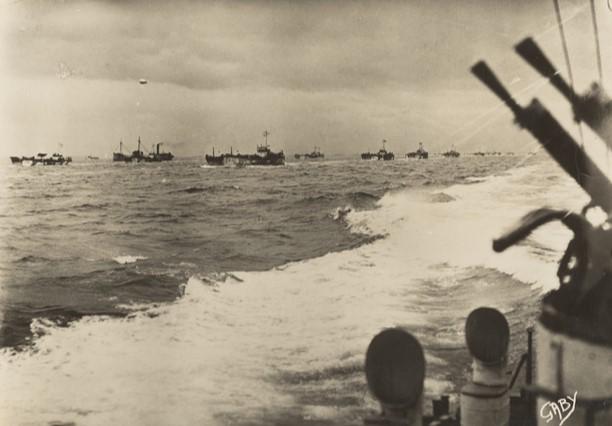
Shortly after midnight on 6 June 1944, Allied forces commenced landing airborne troops in Normandy, France. At dawn, naval vessels would begin landing troops on beaches codenamed Utah and Omaha for the American forces, and Gold, Juno and Sword for the British and Canadians. The landings would be preceded by an immense bombardment by Allied air forces, supported by thousands of fighter aircraft. The naval operation, involving more than 6,000 vessels, was the largest armada ever assembled. It was the first day in the liberation of Western Europe from Nazi occupation.
D–Day is one of the defining events not only of World War II but also of the 20th century. In the West, commemorations marking the anniversary of D–Day have become the most internationally significant events remembering the war. Although the bulk of the forces in the landings were British, American and Canadian, more than a dozen Allied nations participated in the operation.
Few people today likely realise that Australians, predominantly members of the Royal Australian Air Force and Royal Australian Navy, were among those who actively contributed to the operation. Australia had entered the war as a partner in the British Empire in 1939. By 1944 Australian forces and personnel were fighting the war on multiple fronts. Australia remained committed to standing strongly by Britain and continuing the fight against Nazi Germany in Europe, while simultaneously dealing with the immense challenge of facing down the Japanese advance across the Asia–Pacific region, which was turned back from Australia’s own doorstep in 1942.
The stories of the Australian men and women who participated in the battle of Normandy aren’t well known, yet more than 3,300 Australians were active in the D–Day landings (2,800 airmen, 500 sailors, and small numbers of men and women serving with the British Army), while thousands more served during the subsequent Normandy campaign. Thirteen Australians were killed on 6 June, but the campaign lasted beyond that one day. On 7 June, 20 Australian airmen were killed; on 8 June another 22 died, and the losses continued until August. In fact, more than 1,100 Australians were killed in Europe in the build-up to and during the Normandy battle (April–August 1944). To this day, June 1944 remains the costliest month in terms of casualties in the history of the RAAF.
One of the difficulties facing historians in telling the Australian D–Day story is identifying the contributions of thousands of individuals who served attached to British squadrons and naval vessels. No RAN vessel was involved in the landings, but Australian sailors were spread across the British fleet. A small number of Australian officers commanded British destroyers, corvettes, minesweepers, landing craft and torpedo boats. Others served in ships’ companies, some commanding gun turrets aboard heavy cruisers. In the air, 10 RAAF squadrons were involved, and No. 453 Squadron, RAAF, flying the Supermarine Spitfire, operated from the ground in Normandy in the weeks after the landing. But the majority of Australian airmen were spread across more than 200 Royal Air Force squadrons.
All of the Australians who served were volunteers. The airmen who served on D-Day had trained as part of the Empire Air Training Scheme, which saw 16,000 RAAF pilots, navigators, wireless operators, bomb aimers, gunners and flight engineers join RAF squadrons during the course of the war. Another 11,541 men joined RAAF squadrons formed in Britain. On D–Day, 1,000 Australians served in the 10 RAAF squadrons that participated in the Allied invasion. A further 1,800 Australians who participated on D-Day were serving attached to RAF squadrons.
In addition to those in operational squadrons on D-Day, there were 10,000 Australian airmen in training and reserve. Many of them would join operational squadrons as the battle in Normandy raged in the days and weeks after the landing and as casualties to aircrews mounted. To place the RAAF’s contribution—and Australia’s commitment—to the air war in Europe into some perspective, the number of Australian airmen in Britain in July 1944 was equal to the size of an Australian army division in the Pacific at that time.
At sea, RAN sailors served in diverse roles and were involved in all the major naval operations of the war. At least 1,100 members of the RAN served at different times, on attachment to the Royal Navy. Of the 500 serving in June 1944, more than 400 were officers of the Royal Australian Naval Volunteer Reserve. Many had enlisted in Australia under the ‘Yachtsmen Scheme’, which targeted recruits with small-ship experience. These men were ideal for training with Combined Operations and for commanding landing craft and ships.
The stories of these Australians who served in Normandy remain little known, but it is important to remember their contribution to the great Allied effort in 1944. Their service is also a reminder that from the outbreak of war in September 1939 to the final day of victory in 1945, Australia was committed to the defence of Britain and the free world. This included defeating Nazism and fascism in Europe, as well defending Australia from Japanese militarism in Asia and the Pacific.